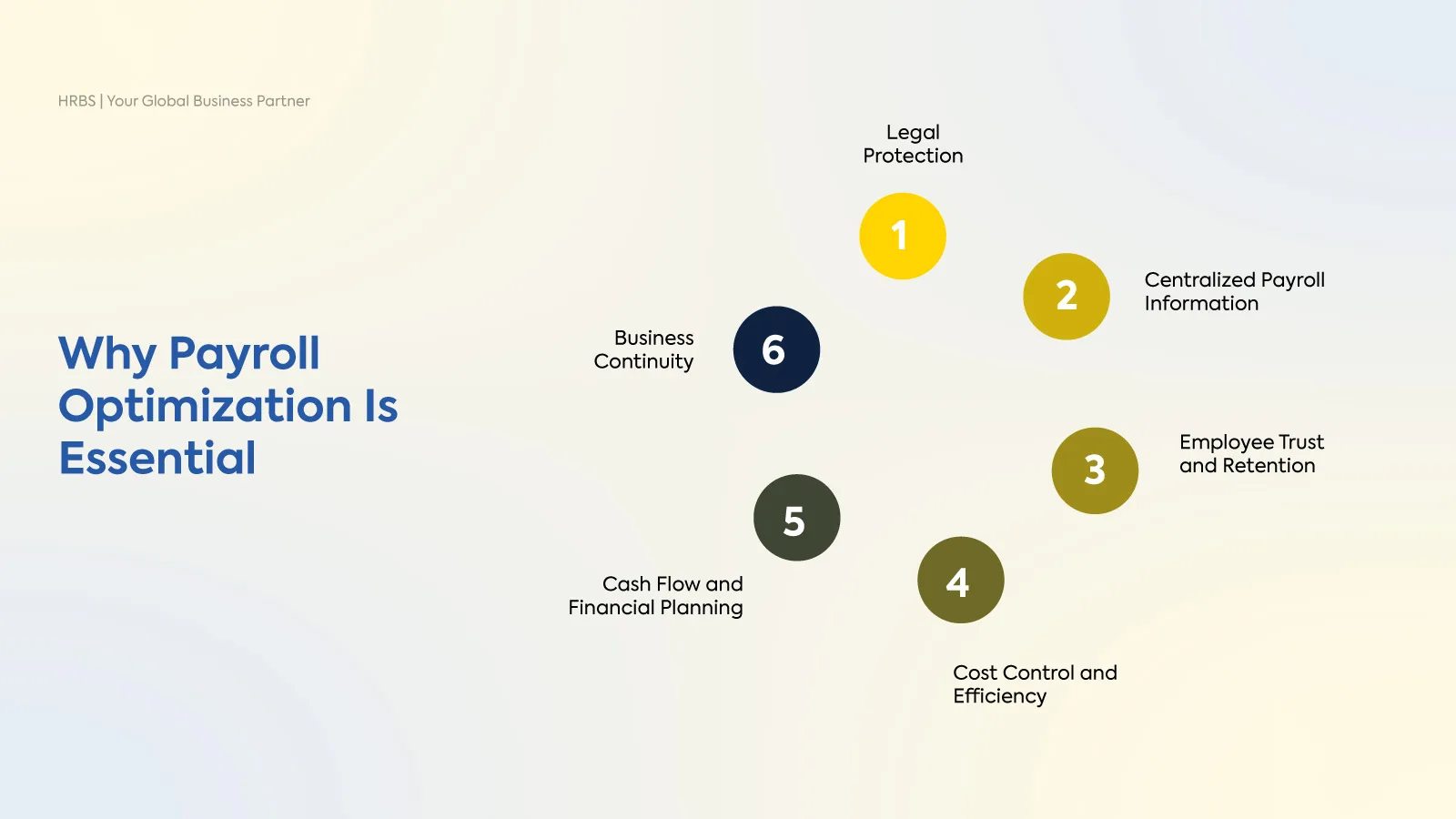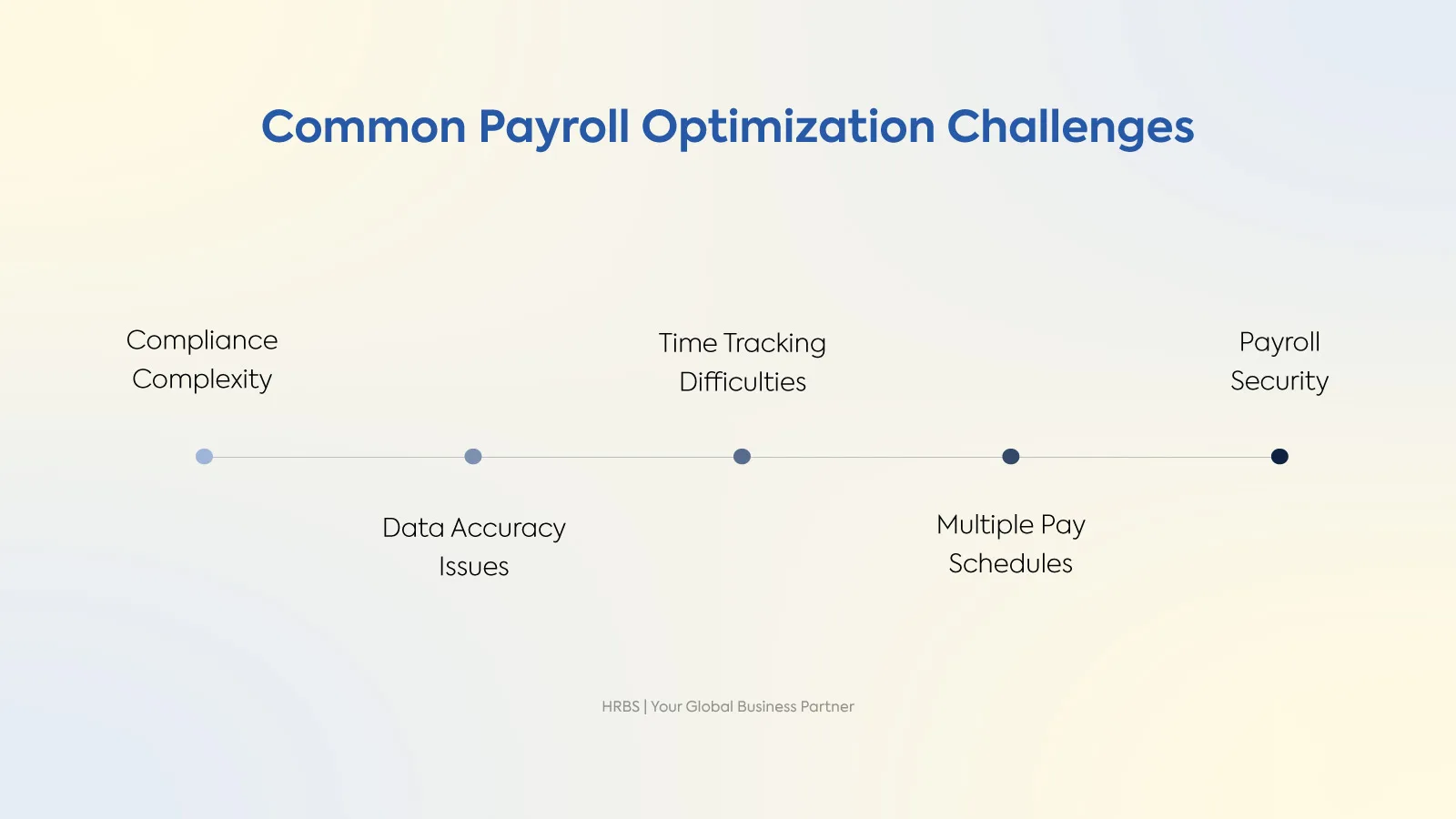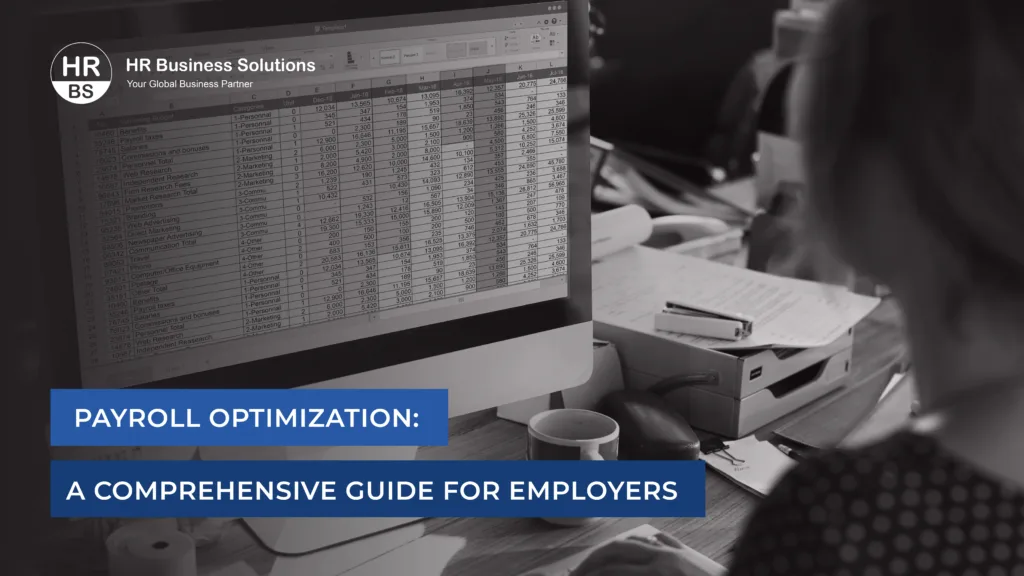Payroll is how businesses pay their employees for the work they do. But it’s not just about signing checks or clicking buttons, a smooth payroll process relies on getting the details right, following tax and labor rules, and making sure everyone gets paid accurately and on time. Whether your team is down the street or spread across different countries, each step matters: collecting the right employee information, calculating pay, and delivering payments securely.
Optimizing your payroll means cutting out unnecessary steps, using technology to reduce errors, and staying up to date with changing regulations, so you avoid fines, save time, and keep your team focused on what really matters. In this guide, you’ll find practical ways to automate routine payroll tasks, spot where errors most often happen, and make compliance easier, no matter how big your company is or where your employees are located.
What is Payroll Optimization?
Payroll optimization means making your payroll process as simple, accurate, and reliable as possible. At its core, it’s about more than just paying employees on time, it’s about implementing clear, efficient steps and leveraging the right tools to minimize errors, accelerate payroll cycles, ensure compliance with tax and labor laws, and protect sensitive employee data.
Practical payroll optimization might include automating timesheet approvals, integrating payroll software with HR, accounting, and time-tracking systems, and providing employees with secure, easy access to their pay information. These actions reduce administrative workload, improve transparency, keep records up to date, and build trust by assuring everyone that their payments are managed correctly and securely.

Why is Payroll Optimization Essential?
Payroll affects every employee and directly impacts business performance. An optimized payroll process is more than just paying people, it provides legal protection, controls costs, builds trust, and strengthens financial planning.
-
- Legal Protection: Payroll involves complex tax and labor laws that vary by country, state, and city, and these rules change frequently. A well-designed payroll process ensures every payment and filing meets current regulations, reducing the risk of costly penalties, audits, and legal challenges.
- Centralized Payroll Information: Using a unified payroll system means all your payroll information is in one place. This includes working hours, deductions, benefits, and taxes, in one place. This improves accuracy by reducing errors and simplifies reporting and auditing. For companies operating in multiple countries, consistent visibility into payroll expenses improves cash flow management and regional budgeting decisions.
- Employee Trust and Retention: Consistently paying employees accurately and on time builds confidence and satisfaction. Payroll reliability reduces disputes and helps maintain high morale, which is crucial for retention and productivity. In competitive labor markets, this trust supports employer branding and employee engagement.
- Cost Control and Efficiency: Payroll errors can cause unexpected costs like late payment fees, bank charges, and administrative burdens from correcting mistakes. An optimized process reduces these errors and unnecessary manual work, freeing resources to focus on growth initiatives. Automation also shortens payroll cycles and lowers operational costs.
- Cash Flow and Financial Planning: Accurate and timely payroll data provides clear insights into labor costs and payment timings. This transparency helps businesses forecast expenses, manage cash flow effectively, and plan for scaling their workforce. It is especially vital for companies with multiple pay schedules or international operations, where timing and currency fluctuations affect financial health.
- Business Continuity: An optimized payroll system supports audit readiness by maintaining detailed payroll records and clear approval workflows. This reduces risks during financial reviews and helps recover quickly from compliance or operational issues. By minimizing errors and ensuring data security, payroll optimization protects the company’s reputation and operational stability.
Key Strategies for Optimizing Payroll Process
A strong payroll process is simple, reliable, and compliant. These strategies focus on practical steps that reduce errors, speed up processing, and protect employee data, without adding extra complexity.
Automate Routine Tasks
- Use trusted payroll software that handles calculations, deductions, filings, and payslip generation. Pair this with time and attendance tools that sync data directly into payroll to reduce manual input and errors.
- Automate tax table updates and form generation to ensure filings are always current and accurate, preventing costly penalties.
Streamline and Standardize
- Map your entire payroll cycle to identify and remove redundant steps. Define clear deadlines, approval processes, and a payroll calendar to avoid last‑minute rushes and missed payments.
- Establish documented rules for off‑cycle payments such as bonuses, corrections, and reimbursements to maintain consistency and avoid manual errors.
Improve Time Tracking
- Adopt automated, mobile-friendly time tracking systems that capture hours in real time and apply your company’s overtime, shift, and break rules automatically.
- Direct syncing of approved hours into payroll eliminates manual data transfers and reduces mistakes.
Employee Self-Service
- Provide employees with secure online access to view payslips, update personal details, download tax documents, and check leave balances.
- Integrate leave and attendance systems with payroll to ensure changes like sick leave or overtime are reflected accurately in pay runs. This not only reduces HR queries but also keeps records accurate and up-to-date.
Prioritize Security Controls
- Protect payroll data with strong encryption, multi-factor authentication, and role-based access controls so only authorized personnel can access sensitive information.
- Maintain detailed audit trails of all approvals and system changes to ensure full transparency and regulatory compliance.
Leverage Data Insights
- Use payroll software that offers real-time reporting and analytics to monitor payroll performance. Tracking key metrics such as accuracy rates, on-time payments, and employee feedback helps identify bottlenecks and areas for improvement.
- Data-driven insights enable proactive management and continuous process optimization.
Ensure Compliance and Scalability
- Stay up to date with evolving local payroll regulations to avoid penalties. Automate tax filings and statutory deductions for accuracy and timeliness.
- Choose payroll systems and services that can scale easily as your business grows or expands internationally, maintaining efficiency regardless of size.

Common Payroll Optimization Challenges
Payroll optimization brings significant benefits, but many businesses face specific challenges that can interrupt a seamless payroll process. Understanding these challenges allows companies to plan better and resolve issues before they affect operations.
- Compliance Complexity: Tax and labor laws change frequently and vary widely by country, state, and city. Businesses with operations in multiple locations must keep up with diverse regulations, deadlines, and reporting requirements. Missing updates or misinterpreting local rules can result in costly fines and audits.
- Data Accuracy Issues: Errors from manual data entry, inconsistent records between HR, timekeeping, and payroll systems, or outdated employee information. Such mistakes can cause incorrect paychecks, tax miscalculations, and benefits errors. These issues reduce employee trust and require additional time to fix.
- Time Tracking Difficulties: Accurately capturing hours worked, overtime, and leave is complex, especially with remote or gig workers and varying schedules. Inaccurate time data directly leads to payroll errors, disputes, and potential legal risks.
- Multiple Pay Schedules: Handling several pay frequencies (weekly, biweekly, monthly, or mixed) creates added complexity, increasing the risk of mistakes. It also complicates cash flow management and payroll reporting.
- Payroll Security: Payroll data includes sensitive personal and financial information, making it a prime target for cyberattacks. Weak access controls, inadequate monitoring, and insecure storage increase the risk of data breaches, identity theft, and fraud.
Trends Shaping the Future of Payroll Optimization
Payroll is rapidly changing as new technologies emerge and workforce dynamics evolve. Staying informed about these trends helps businesses optimize processes, maintain compliance, and remain competitive.
-
- Automation and AI: Automation continues to handle routine payroll tasks such as data entry, tax computations, and compliance checks, reducing errors and saving time. AI enhances these capabilities by detecting anomalies and predicting payroll risks early, enabling smoother runs and fewer last-minute adjustments.
- Real-Time Data Analytics: Modern payroll platforms provide instant insights into labor costs, overtime, and tax obligations. Real-time analytics allow managers to make informed decisions about staffing, budgets, and operational improvements quickly.
- Cloud-Based Platforms: Cloud payroll solutions offer flexibility, security, and accessibility from any location. This is critical for businesses with remote or global teams, as these platforms enable faster updates and easier integration with HR, finance, and time-management tools.
- Compliance and Security Focus: Payroll systems now automatically update tax laws and labor regulations across multiple jurisdictions, reducing the chance of non-compliance and penalties. Enhanced security features—including encryption, multi-factor authentication, and audit logs protect payroll data from breaches.
- Integration: More companies are consolidating payroll, HR, benefits, and accounting software into unified platforms. This reduces duplicated data entry, speeds up processing, and simplifies reporting, delivering a clearer view of total payroll expenses.
How HRBS Help Optimize Payroll Process?
HR Business Solutions play a crucial role in making payroll processes accurate, efficient, and compliant, especially for businesses dealing with complex local regulations and large workforces. Here’s how HRBS help optimize payroll:
- Expert Compliance Management: We keep up with the latest local laws, tax rules, and social security requirements. This means payroll is done the right way to avoid fines and legal problems. We also watch for new rules coming soon, so your payroll stays up to date.
- Accurate Payroll Calculation: With reliable software, we carefully calculate pay, payroll taxes, and employee benefits. This helps avoid common mistakes that can cause delays or unhappy employees. We also handle special cases like bonuses, commissions, or payroll across different places.
- Scalability and Flexibility: As your business grows or changes, we adjust how payroll is managed without interrupting pay runs. Supporting payroll in different countries, multiple pay schedules, and changing benefit plans makes it easier for you to focus on your work, not payroll.
- Clear Communication and Support: We provide easy-to-understand payroll reports and help your team with questions or updates. Giving employees access to their own pay information reduces confusion and keeps everyone informed.
- Data Protection: We protect all sensitive employee payroll information with strong security measures to prevent data leaks or unauthorized access. Regular checks keep security tight and help maintain employee trust.
Every payroll cycle is an opportunity to get it right and build trust. We make sure every pay run is accurate, secure, and fully compliant, while giving you a single, reliable source for payroll and payments. Book a free consultation to see how we can streamline your payroll and keep every payment on track.
FAQ’s
What are the most common challenges businesses face in payroll optimization?
Common challenges include keeping employee records updated, especially with seasonal or contract workers; accurately tracking time and attendance; managing diverse payroll schedules; staying compliant with ever-evolving tax and labor regulations; and ensuring data security to protect sensitive employee information. Addressing these areas proactively is critical to a smooth payroll process.
How can automation improve payroll accuracy and efficiency?
Automation reduces manual data entry, eliminating human error in wage calculations, tax deductions, and benefits administration. Automated payroll systems also accelerate processing times by handling repetitive tasks such as tax filings, generating pay slips, and reconciling accounts seamlessly. This leads to faster payroll cycles and fewer compliance risks.
What role does integration between payroll and other business systems play in optimization?
Integrating payroll with HR, accounting, and time-tracking systems ensures data consistency and reduces duplication of effort. This integration streamlines workflows by synchronizing employee data, benefit deductions, and attendance records in real time, improving accuracy and enabling comprehensive reporting for better decision-making.
How important is compliance in payroll optimization, and how can businesses maintain it?
Compliance is essential to avoid penalties and legal issues. Businesses must stay current with federal, state, and local tax laws, labor standards, and reporting requirements. Utilizing payroll solutions that update tax tables automatically, conducting regular audits, and consulting with payroll experts ensure adherence to all regulatory obligations.
What benefits do employee self-service portals bring to payroll optimization?
Self-service portals empower employees to access pay information, update personal details, and manage benefits independently. This reduces the administrative workload on HR departments, minimizes errors caused by outdated information, and increases transparency, which enhances employee trust and satisfaction.


